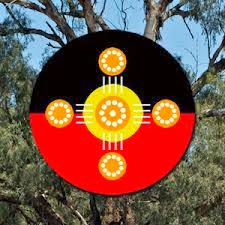Australia is known as the continent and country with the highest concentration of micronations, those obscure whimsical independence projects enacted by eccentrics of which the government in Canberra is surprisingly tolerant. Some have been covered in this blog, such as the Principality of Hutt River (among the most serious of them) to the Free State of Australia (see also follow-up article here) to the recent attempt by a resort island near Brisbane, Queensland, to declare itself the Independent Republic of Nguduroodistan. Others include the Principality of Snake Hill, the Empire of Atlantium, the Principality of Dubeldeka, and, in the Great Barrier Reef, the Gay and Lesbian Kingdom of the Coral Sea Islands. Some are no larger than the homes or properties of their self-styled princes and queens.
 |
| Symbol of the Australian Aboriginal “Sovereign Union” movement |
 |
| Australian Aboriginal and other indigenous activists showing solidarity with the West Papua independence movement in neighboring Indonesia |
 |
| The proclaimed territory of the Murrawarri Republic is about the size of Austria. |
 |
| The Euahlayi Peoples Republic also straddles the Queensland–New South Wales border, just east of the Murrawarri Republic. |
What is new about these Aboriginal declarations is that they are being made in the name of individual Aboriginal nations, as opposed to previous movements to, for example, plans by the Aboriginal Provisional Government in the 1990s to declare a vast, landlocked Aboriginal State. Of the four above-listed nations, the Republic of Mbarbaram and the Wiradjuri Central West Republic have not, to my knowledge, revealed their precise territories, though the Wiradjuri republic’s flag features the outline of the territory, which seems to be—and this is supported by the republic’s full name—a subset of the vast homeland of the Wiradjuri people, which is the largest in Australia and includes up to a third of N.S.W., including the city of Wagga Wagga. One news report said the republic’s territory “would cover the areas around Goolma, Wellington, Parkes, Forbes and Orange.”
 |
| Map showing Wiradjuri territory (in New South Wales) among other Aboriginal homelands in Australia. |
Indeed, all of these new states, but the Wiradjuri republic especially, are claiming territories that also include large numbers, even majorities, of non-Aboriginals. But Aboriginal activists insist this is not a problem, that the new states will be cooperative and inclusive. It’s not clear if local whites necessarily share that optimism.
 |
| Flag of the Euahlayi Peoples Republic |
 |
| Flag of the Murrawarri Republic |
[For those who are wondering, yes, this blog is tied in with my forthcoming book, a sort of encyclopedic atlas to be published by Auslander and Fox under the title Let’s Split! A Complete Guide to Separatist Movements, Independence Struggles, Breakaway Republics, Rebel Provinces, Pseudostates, Puppet States, Tribal Fiefdoms, Micronations, and Do-It-Yourself Countries, from Chiapas to Chechnya and Tibet to Texas. The book, which contains dozens of maps and over 500 flags, is now in the layout phase and should be on shelves, and available on Amazon, by early fall 2014. I will be keeping readers posted of further publication news. Meanwhile, please “like” the book (even though you haven’t read it yet) on Facebook.]


I just want to say your blog is awesome, I look forward to your book and solidarity to the indigenous people of Australia!
ReplyDelete